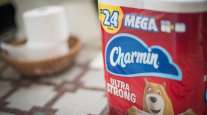Retail Sales Decline After January Revised Down

U.S. retail sales dropped in February and the prior month’s gain was revised to a decline, calling into question the narrative that bigger gains in consumer spending would propel economic growth at the start of 2016.
The 0.1% decline in purchases followed a revised 0.4% January decrease, Commerce Department figures showed March 15. Sales excluding gasoline rose 0.2% in February, reversing the previous month’s retreat.
The decrease in purchases, which included auto dealers, department stores and furniture outlets, showed Americans were salting away money saved at the gas pump amid volatile financial markets. The disappointing reading on the biggest part of the economy comes as Federal Reserve officials meet to gauge whether growth is strong enough to warrant another increase in interest rates.
“We’re seeing higher rents, higher health-care expenses, so that may be offsetting a lot of the benefit of lower gasoline prices,” said Scott Brown, chief economist at Raymond James Financial Inc. in St. Petersburg, Florida. “You’re still looking at strong job growth, good wage growth, and wages should continue to pick up as the labor market tightens.”
The median forecast in a Bloomberg News survey called for a 0.2% drop in February, with estimates ranging from a decline of 0.7% to a 0.4% gain. January’s reading was initially reported as a 0.2% increase.
The January revision reflected big downward adjustments to sales of electronics and appliances, building materials, personal-care items and department-store merchandise.
In February, eight of 13 major retail categories showed declines, indicating the drop also was broad-based. Purchases at furniture outlets decreased 0.5%, and sales at general merchandise stores fell 0.2%.
Core sales, the figures that are used to calculate gross domestic product and which exclude such categories as autos, gasoline stations and building materials, were unchanged last month after a revised 0.2% increase in January. The prior month had previously been recorded as a 0.6% gain.
Service-station receipts dropped 4.4%, the most since September, on lower gasoline costs. Auto dealers fell 0.2% in February, matching the drop a month earlier. Purchases excluding autos and gasoline rose 0.3% after a 0.1% decline.
The auto figures are in line with industry data, which eased a bit in February. Cars and light trucks sold at a 17.4 million annualized rate last month, based on Ward’s Automotive Group data.
Retail sales excluding autos fell 0.1% after a 0.4% decrease in January, according to the report.
Households are finding support from still-cheap fuel costs and a strengthening labor market. The average cost of a gallon of regular gasoline was $1.94 on March 13, according to AAA, the biggest U.S. motoring group. While prices at the pump have been rising for the past month, the latest figure compares with an average $2.40 in 2015.
Payrolls climbed by a more-than-forecast 242,000 in February, while the unemployment rate held at an eight-year low of 4.9%.
Household spending, which makes up about 70% of the economy, may accelerate in the first three months of this year, according to economists’ projections as of March 14. Consumer purchases will rise at a 2.9% annualized pace in the first quarter after a 2% rate in the previous three months, according to the data compiled by Bloomberg.




